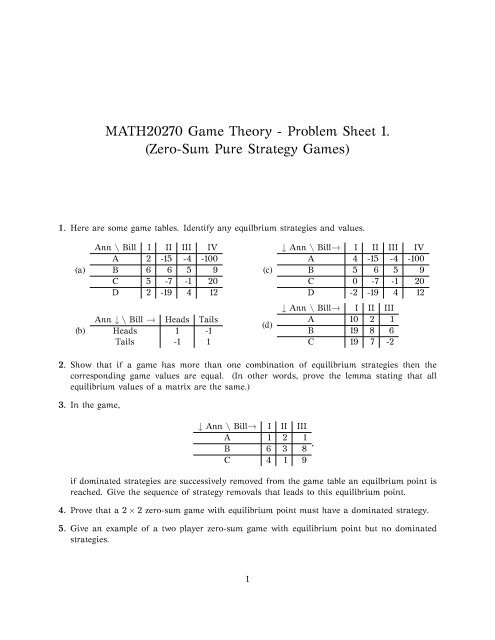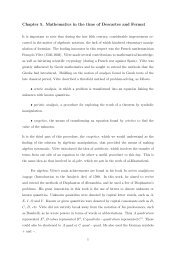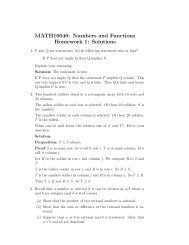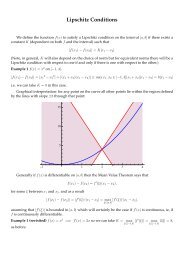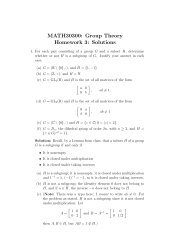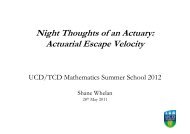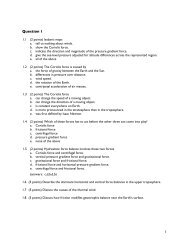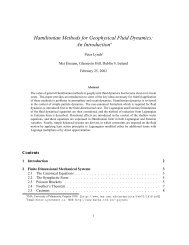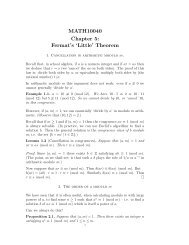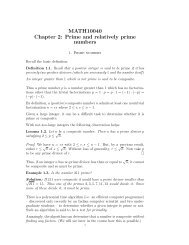MATH20270 Game Theory - Problem Sheet 1. Zero-Sum Pure ...
MATH20270 Game Theory - Problem Sheet 1. Zero-Sum Pure ...
MATH20270 Game Theory - Problem Sheet 1. Zero-Sum Pure ...
You also want an ePaper? Increase the reach of your titles
YUMPU automatically turns print PDFs into web optimized ePapers that Google loves.
<strong>MATH20270</strong> <strong>Game</strong> <strong>Theory</strong> - <strong>Problem</strong> <strong>Sheet</strong> <strong>1.</strong><br />
(<strong>Zero</strong>-<strong>Sum</strong> <strong>Pure</strong> Strategy <strong>Game</strong>s)<br />
<strong>1.</strong> Here are some game tables. Identify any equilbrium strategies and values.<br />
(a)<br />
Ann \ Bill I II III IV<br />
A 2 -15 -4 -100<br />
B 6 6 5 9<br />
C 5 -7 -1 20<br />
D 2 -19 4 12<br />
(c)<br />
↓ Ann \ Bill→ I II III IV<br />
A 4 -15 -4 -100<br />
B 5 6 5 9<br />
C 0 -7 -1 20<br />
D -2 -19 4 12<br />
(b)<br />
Ann ↓ \ Bill → Heads Tails<br />
Heads 1 -1<br />
Tails -1 1<br />
(d)<br />
↓ Ann \ Bill→ I II III<br />
A 10 2 1<br />
B 19 8 6<br />
C 19 7 -2<br />
2. Show that if a game has more than one combination of equilibrium strategies then the<br />
corresponding game values are equal. (In other words, prove the lemma stating that all<br />
equilibrium values of a matrix are the same.)<br />
3. In the game,<br />
↓ Ann \ Bill→ I II III<br />
A 1 2 1<br />
B 6 3 8<br />
C 4 1 9<br />
if dominated strategies are successively removed from the game table an equilbrium point is<br />
reached. Give the sequence of strategy removals that leads to this equilibrium point.<br />
4. Prove that a 2 × 2 zero-sum game with equilibrium point must have a dominated strategy.<br />
5. Give an example of a two player zero-sum game with equilibrium point but no dominated<br />
strategies.<br />
,<br />
1
6. Simplify the following games by removing any dominated strategies:<br />
(a)<br />
↓ Ann \ Bill→ I II III<br />
A 1 -2 -5<br />
B -1 1 -3<br />
C 0 2 4<br />
(b)<br />
↓ Ann \ Bill→ I II III<br />
A 4 -3 -1<br />
B 0 -1 -1<br />
C 0 -1 -2<br />
(c)<br />
↓ Ann \ Bill→ I II III IV V<br />
A 1 -2 -4 -3 4<br />
B -1 2 0 -3 -4<br />
C 0 3 1 -1 0<br />
7. For this exercise, you will need to go to the course web page mathsci.ucd.ie/modules/math20270<br />
and click on the Random <strong>Game</strong> Generator. Enter your student number and generate a 3 × 3<br />
zero-sum game. Write down the reference number for the game table produced when answering<br />
the following:<br />
(a)<br />
i. Calculate the maximin and minimax of the game.<br />
ii. Does the game have an equilibrium point?<br />
iii. Simplify the game as much as possible by removing any dominated strategies.<br />
(b) Repeat, this time with a generated 5 × 5 game.<br />
8. Show that, in any two player zero-sum game, the maximin value is always less than or equal<br />
to the minimax value.<br />
9. Prove that a two player zero-sum game has an equilibrium point (i.e. an entry which is<br />
smallest in its row and largest in its column) if, and only if, the maximin and minimax<br />
values are equal.<br />
10. Write down a game table representing the well-known game of “Rock-Paper-Scissors”. Calculate<br />
the maximin and minimax values. Does this game have an equilibrium point?<br />
2


